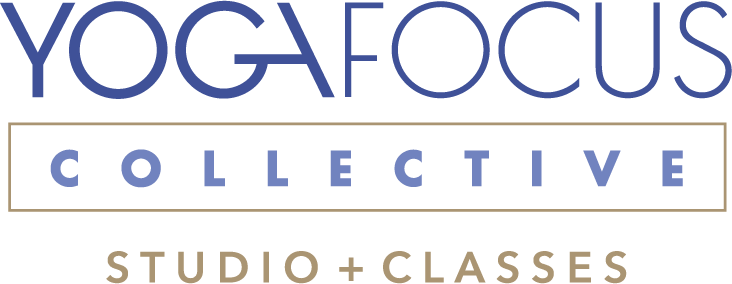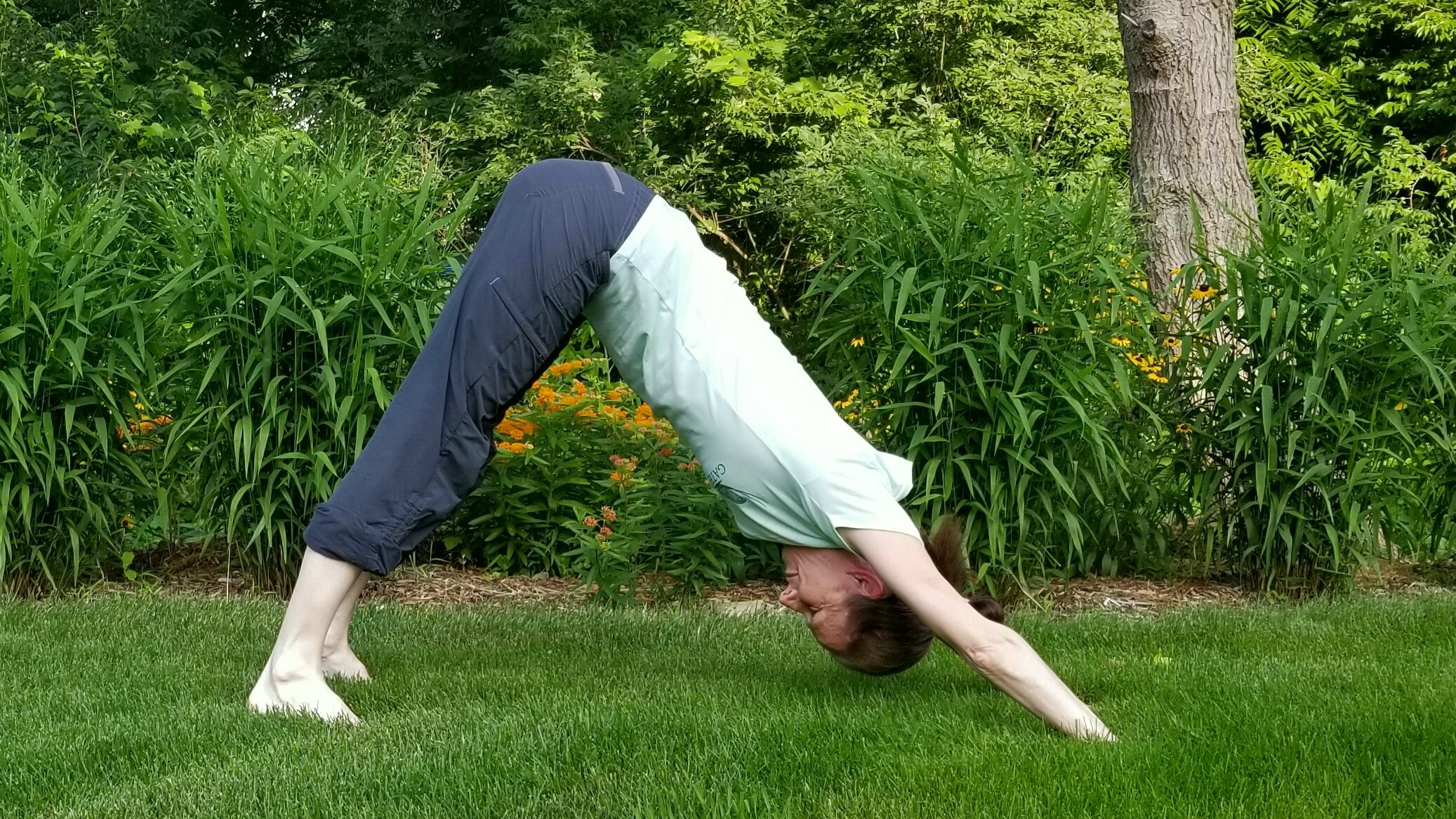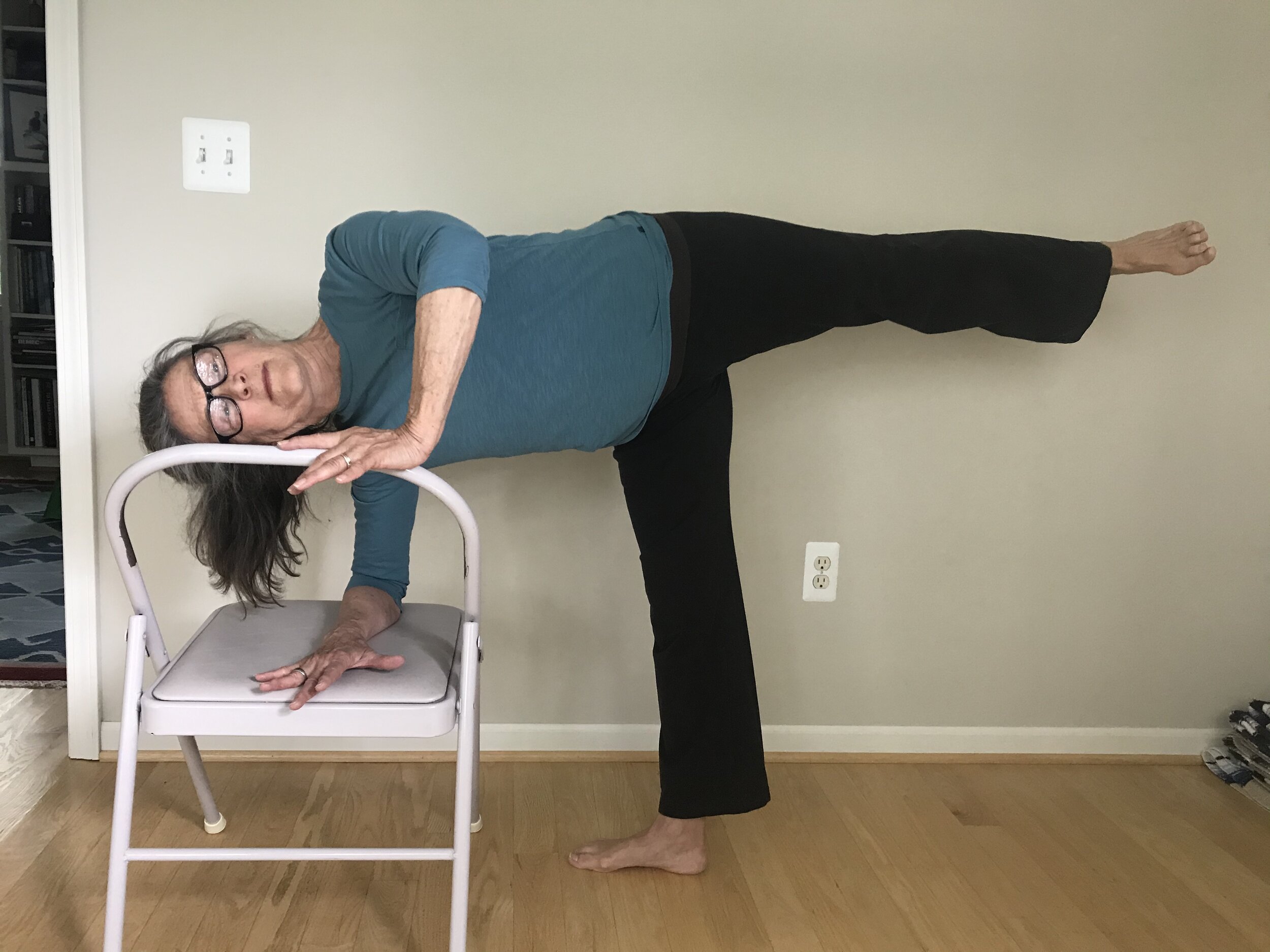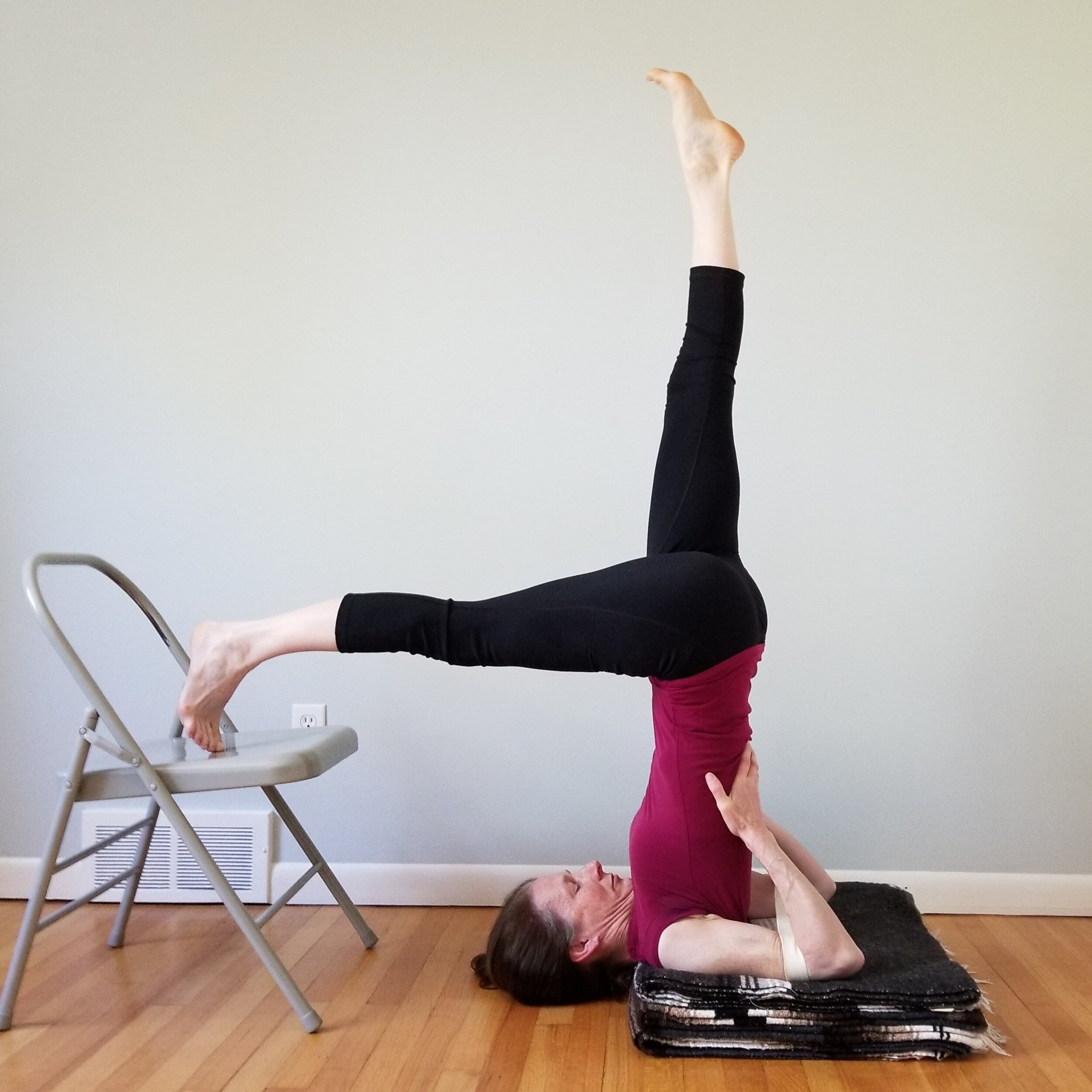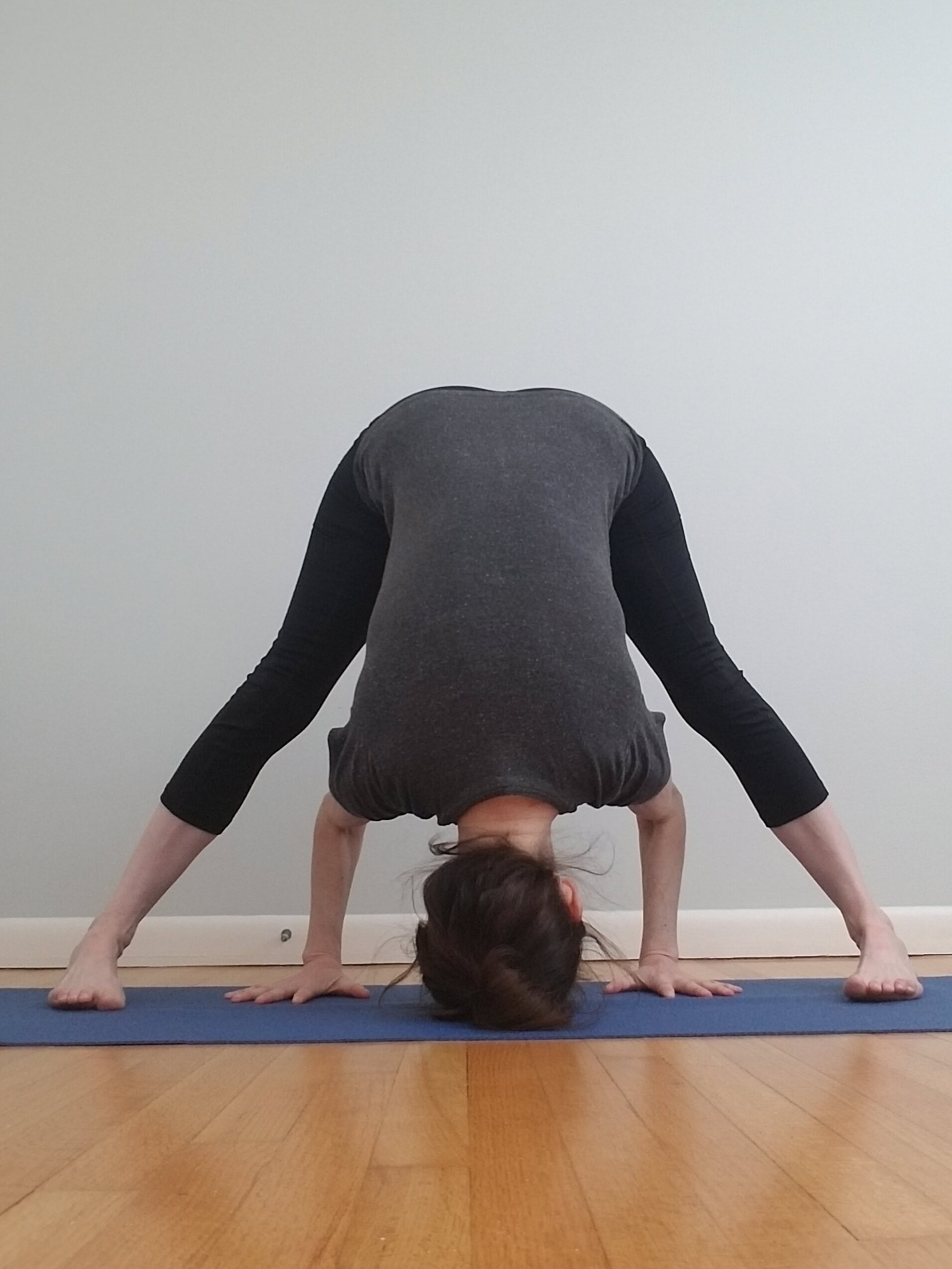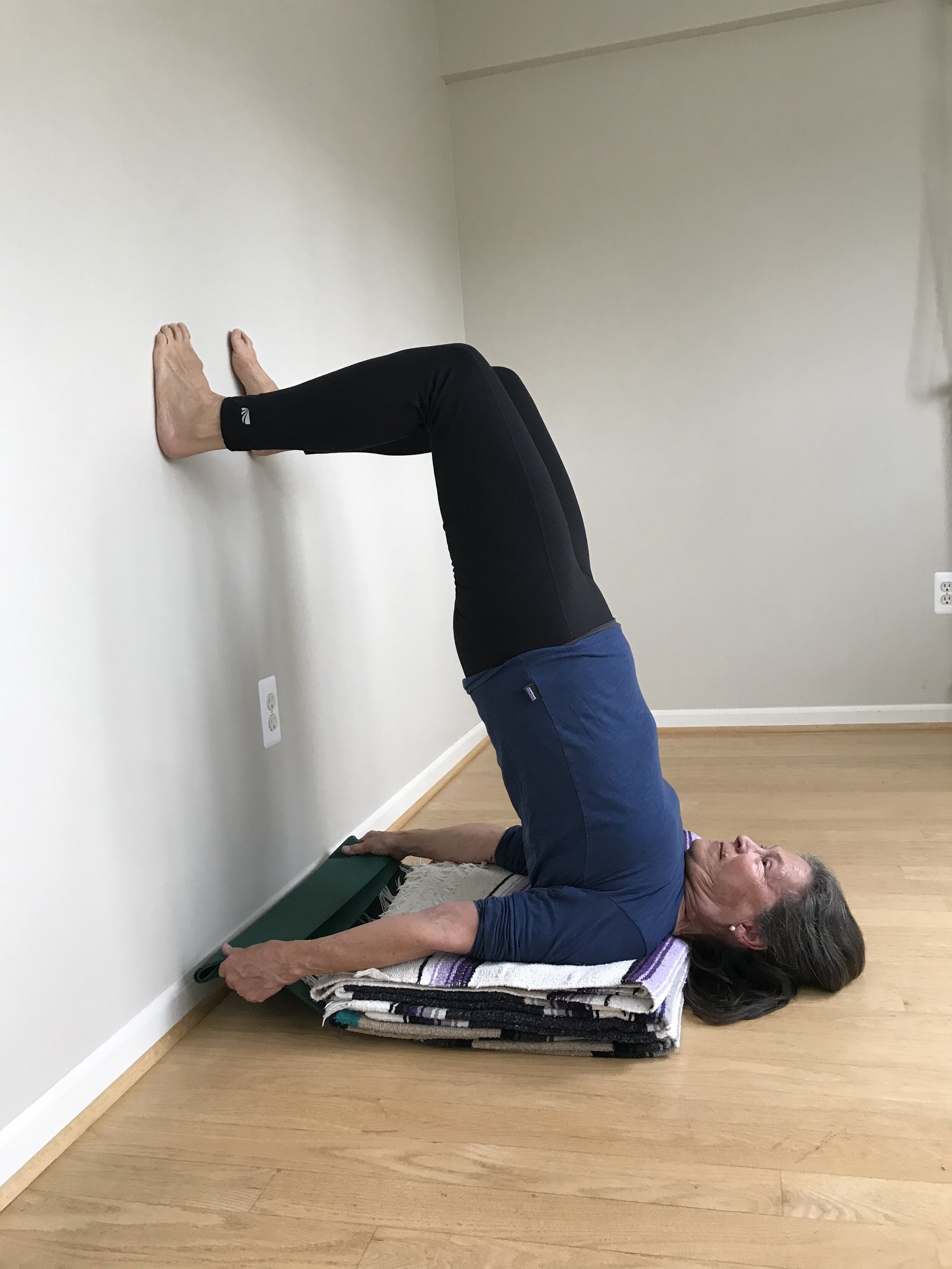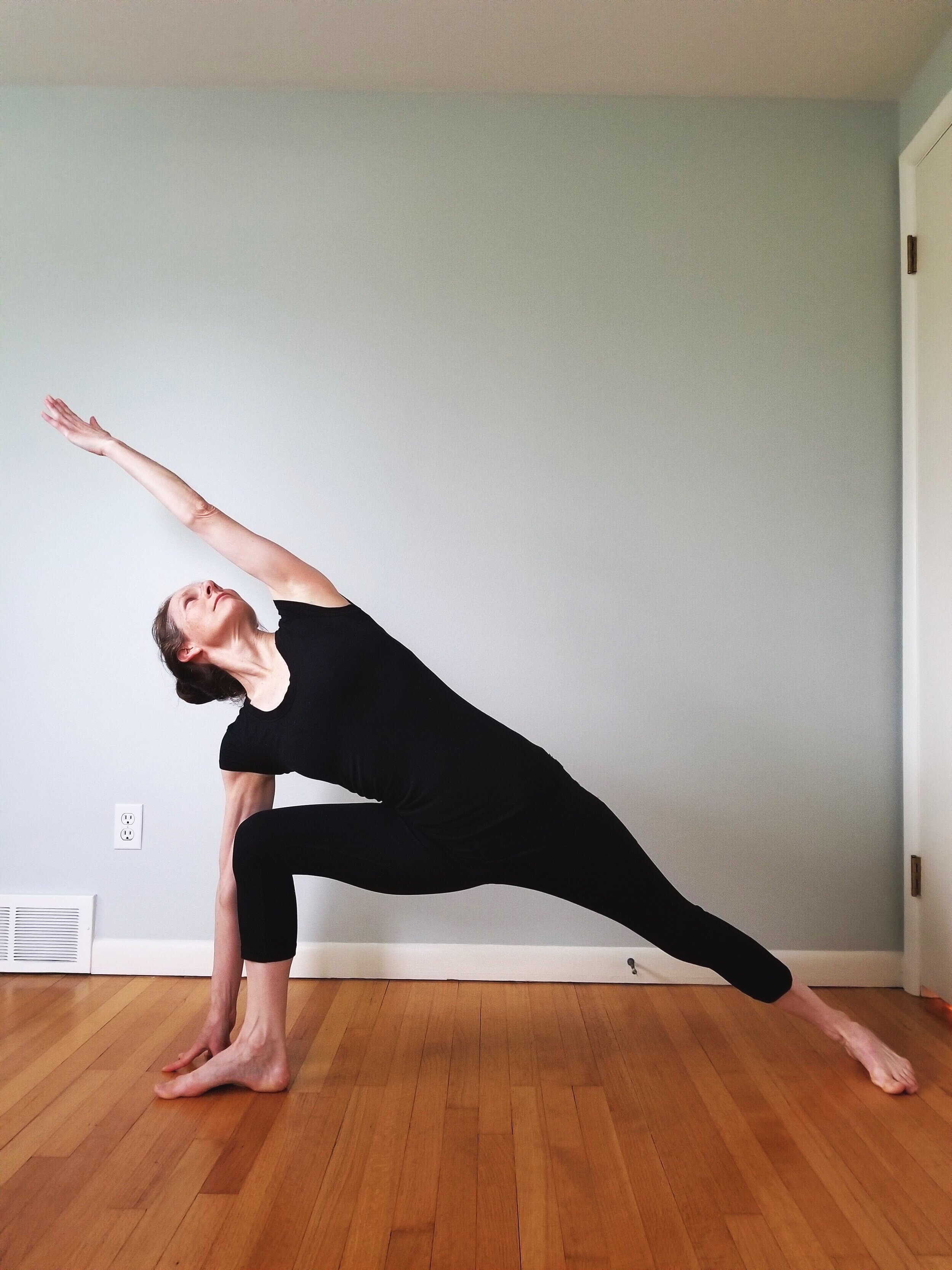sequences for home practice
“REGULAR PRACTICE OF YOGA CAN HELP YOU FACE THE TURMOIL OF LIFE WITH STEADINESS AND STABILITY.”
-B.K.S. Iyengar
Pratyahara
Pratyahara, the fifth limb of yoga, means withdrawal of the senses. Patanjali Yoga Sutras describes pratyahara as a threshold between the outer and inner quests of yoga. Outer yogic practices include wholesome interactions with others, culture of the body through asana, and control of the breath while the inner quest refers to the more subtle practices of concentration and meditation which lead to a quiet mind.
In The Tree of Yoga, BKS Iyengar likens pratyahara to the bark of a tree. The bark creates a barrier that protects against disease and preserves the essence of the tree, the sap, so that the tree will be nourished and eventually bear fruit.
When using asana as a vehicle to explore pratyahara, the question is more how to practice than what particular poses to practice. Choosing poses that can be held without strain for longer timings is a sound approach. Observing the breath, relaxing the eyes and temples, maintaining focus on the actions of the pose, and recognizing thoughts and emotions that arise without reacting to them lays a firm foundation for pratyahara. Below are two recommended sequences. The printable PDF includes suggestions on timings, props, and methods of working in the poses. -Alicia
Sequence I
Tadasana
Utthita trikonasana
Utthita parsvakonasana
Prasarita padottanasana
Uttanasana
Adho mukha svanasana
Adho mukha virasana
Sirsasana
Salamba sarvangasana
Halasana
Janu sirsasana
Paschimottanasana
Supta baddha konasana
Savasana supported with Ujjayi I-IV
Savasana
Sequence II
Swastikasana
Virasana and cycle
Dandasana
Upavistha konasana
Baddha konasana
Malasana
Marichyasana 3
Jathara parivartanasna
Adho mukha svanasana
Setu bandha on brick
Savasana
Fall Season Asana Practice
Fall brings a dramatic display of nature transformed...cooler temperatures and waning daylight, abundant harvests and vibrant colors.
Yoga has been defined as the art of transformation. Asana, the practice of physical postures, provides a solid foundation for yoga study. In the poses, we begin with what is basic and familiar. We progress from the known to the unknown, from the gross to the subtle. Classical yoga texts use the term koshas (layers) to describe this progression of self study, beginning with the outermost (physical) and eventually penetrating the innermost (spiritual) aspects of oneself. In the Yoga Sutras, Patanjali lists several obstacles that impede progress on the yoga path, but states in Sutra 1.21 that "the goal is near for those who are supremely vigorous and intense in practice." The goal that Patanjali speaks of is samadhi. BKS Iyengar's commentary on this sutra defines this eighth limb of yoga as a "profound state of serenity".
Reading and reflecting on the classical yoga texts provides meaningful context for the practice of asana. Exploring the poses for their physical benefits is a starting point, but persistent practice yields other fruits including mental quietude and emotional stability. In BKS Iyengar's words, "Yoga is the golden key which unlocks the door to peace, tranquility, and joy."
The Fall practice sequence below features poses from all categories. Newer students or those wishing a shorter sequence may practice only those poses with an asterisk, while those with more experience may practice the entire sequence. The printable PDF includes practice tips and recommended resources for deeper study. — Alicia
* Siddhasana
* Tadasana
* Utthita trikonasana
Parivrtti trikonasana
* Utthita parsvakonasana
Parivrtti parsvakonasana
* Ardha chandrasana
Parivrtti ardha chandrasana
* Adho mukha svanasana
* Urdhva mukha svanasana
* Prasarita padottanasana I
Prasarita padottanasana II
* Urdhva prasarita padasana
Jathara parivartanasana
Sirsasana I
*Adho mukha virasana
* Virasana and cycle
Paryankasana
Pincha mayurasana
Salamba sarvangasana dropping to setubandha
* Setubandha sarvangasana with support
* Savasana
balance
Balance, in its relationship to strength, is integral to all movement. Every asana allows opportunities to practice balance but none is as essential as Tadasana. In Light On Yoga, Mr. Iyengar speaks to the correct method of standing:
”People do not pay attention to the correct method of standing. Some stand with the body weight thrown only on one leg, or with one leg turned completely sideways. Others bear all the weight on the heels, or on the inner or outer edges of the feet. This can be noticed by watching where the heels and soles of our shoes wear out. Owing to our faulty method of standing and not distributing the body weight evenly on the feet, we acquire specific deformities which hamper spinal elasticity. Even if we keep the feet apart, it is better to keep the heel and toe parallel to the median plane and not at an angle. By this method, the hips are contracted, the abdomen pulled in and the chest is brought forward. One feels lighter in body and the mind acquires agility. If we stand only with the body weight on the heels, we feel the gravity changing; the hips become loose, the abdomen protrudes, the body hangs back and the spine feels the strain and consequently we soon feel fatigued and the mine becomes dull.”
- B. K. S. Iyengar
In the following short sequence, the plate numbers in Light On Yoga of the classic poses are noted. When needed, use the wall, blocks, a chair to give a deeper understanding of the pose. Look for aspects of Tadasana in each of the poses. -Karen
Tadasana (plate 1)
Prasarita Padottanasana-straight arms (plate 30)
Tadasana
Utkatasana (plate 42)
Tadasana
Marichyasana III-standing with one foot on a chair (plate 303/304)
Virabhadrasana I-both legs straight (plate14)
Tadasana
Ardha Chandrasana (plate 19)
Plank pose
Adho Mukha Svanasana (plate 75)
Sirsasana-use the wall if needed (plate 184/185)) or repeat Prasarita Padottanasana
Sarvangasana-feet on wall with legs bent or classic pose (plate 223/224/234)
Savasana (plate 592)
Adho mukha svanasana
Essential Poses for Summer Practice
Yoga practice can be adapted not only to the needs of the individual, but also to the changing seasons and even the time of day. Use the printable PDF below to guide your summer practice, or as a launching point for customizing your own asana sequences. Included are sample sequences for morning and evening practice, and for beginning as well as experienced students. —Alicia
Printable PDF of essential poses for summer practice
ardha chandrasana
The half moon pose, ardha meaning half and chandra meaning moon, gives so many gifts for legs, knees, hips, spine and balance. Like all of the standing poses, this pose asks for and gives back both strength and elasticity. Mr. Iyengar, in Light On Yoga plate 18 and 19, speaks to the toning of the spine and the nerves that connect to our legs.
It is part of the standing pose series but can be integrated into a practice of lateral extensions or balance poses. There is a quiet yet powerful quality to the pose as a pure balance. But with the understanding that all yoga poses are balances, the pose can be practiced with a wall, a chair or a kitchen counter. It is often said that one of the legacies of Mr. Iyengar’s life work will be the brilliance of his use of props. This is not necessarily to make the pose easier, but to give us some of the essence.
In Light On The Yoga Sutras of Patanjali, yoga sutra III.2 translated by Mr. Iyengar, says “A steady, continuous flow of attention directed towards the same point or region is meditation.” While we may aim for strength and range of movement in yoga, we also create for the possibilities for peace and serenity. —Karen
poses to alleviate eye strain
In Yoga: The Path to Holistic Health (Chapter 7, Yoga for Ailments) B.K.S. Iyengar outlines an asana sequence to relieve headache and eye strain. Forward bends, mild inversions, supine poses, and introductory pranayama are included. Head support and eye covering are emphasized throughout. The abbreviated sequence below is for practitioners with no underlying medical conditions affecting the eyes. The printable PDF includes recommended timings, props, modifications, and related sutra study. -- Alicia
Adho mukha virasana
Prasarita padottanasana
Adho mukha svanasana
Uttanasana
Ardha halasana
Supta baddha konasana
Setubandha sarvangasana
Viparita karani
Supported savasana
Ujjayi pranayama in supported savasana
Eka pada sarvangasana
consolidation
Regarding asana practice, B.K.S. Iyengar has said that "our body is the bow and the asanas are the arrows to hit the target- the soul." In this sequence for experienced students, a wide variety of postures are given as preparation for the pinnacle pose, eka pada sarvangasana. Refer to the earlier post on Salamba Sarvangasana, as well as the printable PDF below for practice guidance and related sutra study. —Alicia
Virasana and cycle
Bharadvajasana I
Adho mukha svanasana
Supta padangusthasana I
Urdhva prasarita padasana
Utthita hasta padangusthasana
Virabhadrasana III
Adho mukha svanasana
Adho mukha vrksasana
Uttanasana
Sirsasana
Halasana
Salamba sarvangasana
Eka pada sarvangasana
Halasana
Savasana
Prasarita Padottanasana
Prasarita padottanasana means "spread apart feet intense stretch." This pose tones the legs, spine, and abdomen. Progressive refinement of its symmetrical shape improves balance and whole-body awareness. Combining the active work of standing with the repose of an inversion and forward bend, prasarita padottanasana provides a study of the twin pillars of yoga, practice and detachment. The PDF below includes practice tips, sequencing guidelines, and related sutra study. —Alicia
Printable PDF for Prasarita padottanasana
chatush padasana
Chatush Padasana means hands holding feet or in this pose the hands interlocked. This pose in Iyengar Yoga is considered to be both active and restorative. The legs actively lift the hips and expand the chest. The expansion of the chest benefits the lungs and the heart. Because the head and neck are lower than the heart, the pose is also a mild inversion. The muscular skeletal benefits are present in the active legs, the rotation of the arms and shoulders to open the chest and the elasticity of the spine in extension. Repeat interlocking the hands the other way. Folks with high blood pressure should seek the guidance of a teacher. The breath should not be held or the facial muscles tensed. Especially in these times, an expansive pose is needed. —David
Vasisthasana
adho mukha svanasana series
This series highlights movement with Adho Mukha Svanasana (svana-dog and adho mukha-face downward) as the facilitating, repeating pose. The poses can be held briefly or longer as you see fit for that particular practice. Light On Yoga, as always, remains our reference and the teachings our guide. If there is a pose that you can not do, modify it with props or go on to the next pose. Always consult with your teacher (through our Contact Us Page) if you have concerns or questions. —Karen
Adho Mukha Virasana (plate 92) or do seated supported Virasana
Adho Mukha Svanasaana (plate 75)
Uttanasana (plates 47-48) first concave back with hands on floor or blocks
Adho Mukha Svanasana
Uttanasana-hands on floor or hold legs
Adho Mukha Svanasana
Uttanasana into
Parsvottanasana (plate 26) 1st right foot, then left forward, concave back
Uttanasana into
Parsvottanasana 1st right foot, then left foot forward, hands on floor or hold front leg
Uttanasana into
Adho Mukha Svanasana variation, 1 leg up, Adho Mukha Svanasana, then second leg
Adho Mukha Svanasana
Chaturanga Dandasana (plate 67)
Adho Mukha Svanasana
Vasisthasana (intermediate stage, plate 396) both sides
Adho Mukha Svanasana
Uttanasana into
Utkaatasana (plate 42)
Adho Mukha Svanasana
Prasarita Padottasana (plates 30-34) concave back into full pose with head supported
Adho Mukha Svanasana
Adho Mukha Virasana
Savasana (plate 592)
Poses for the Lower Back
These modified poses offer relief for the lower back by releasing tight hips, hamstrings, and spinal muscles and improving abdominal tone. This sequence can be practiced in 30 minutes or expanded for deeper study. Through focused attention on a particular area of the body, this sequence cultivates dharana, or concentration, the sixth limb of yoga. See the printable PDF for detailed practice notes. —Alicia
Ardha uttanasana
Utthita parsvakonasana
Prasarita padottanasana
Adho mukha svanasana
Supta padangusthasana I
Urdhva prasarita padasana
Jathara parivartanasana
Kurmasana on chair
Savasana
Printable PDF of lower back sequence
TWIST SEQUENCE
Practice twists to relieve stiffness, correct postural imbalance, improve digestion, and increase circulation. This active sequence opens with poses to extend the spine and mobilize the shoulders. The twists progress from standing to seated, targeting every region of the spine. The printable PDF includes practice tips, modifications, and related sutra study. —Alicia
Adho mukha virasana
Adho mukha svanasana
Uttanasana
Tadasana with arm work
Adho mukha vrksasana
Marichyasana standing
Bharadvajasana on chair
Pasasana on chair
Marichyasana III
Pasasana
Adho mukha svanasana
Adho mukha virasana
Savasana
Salamba Sarvangasana I, Supported Shoulderstand
“The importance of Sarvangasana can not be over emphasized.” B.K.S. Iyengar
In Light on Yoga, there is more than a full page of effects/benefits derived from the regular practice of this asana. Mr. Iyengar describes this pose as an “asana that strives for harmony and happiness in the human system.”
The translation of Salamba Sarvangasana means sarva or all/whole, and anga or limb/body. Salamba is support. “In this pose, the whole body benefits from the exercise/asana.”
Please refer to Light on Yoga, Salamba Sarvangasana I plates 219-224 along with the effects at the end of the instructions. If there are restrictions, use the support of the wall or a chair. Always use the support of blankets under the shoulders to help get the balance on the outer shoulders and outer elbows. Please do not do this pose without a teacher if you suffer from high blood pressure. —Karen
Restorative Sequence
This restorative sequence features chest opening and inverted poses to promote respiratory health, mental quiet, and relaxation. The printable PDF includes recommended props, timings, modifications, and readings for deeper study. With supportive props and long holds, restoratives offer a direct experience of Patanjal's Yoga Sutra II.46, "Asana is perfect firmness of body, steadiness of intelligence, and benevolence of spirit." —Alicia
Supta baddha konasana
Supta swastikasana
Supta virasana
Adho mukha virasana
Sirsasana
Viparita dandasana
Salamba sarvangasana
Setubandha sarvangasana
Viparita karani
Savasana
Light on Yoga, Appendix I, Week I (for all levels)
Standing poses develop stamina, strength, balance, and flexibility. Inverted poses require that we observe ourselves and our environment from a fresh perspective, cultivating mental focus and the ability to draw attention inward. Beginners may practice legs up the wall instead of Sarvangasana and Halasana. In the standing poses, hold for 30 seconds to 1 minute per side, repeating each twice. End with 10 minutes of savasana. —Alicia
Tadasana
Vrksasana
Utthita Trikonasana
Utthita Parsvakonasana
Virabhadrasana I
Virabhadrasana II
Parsvottanasana
Salamba Sarvangasana I
Halasana
Savasana
An encasement sequence, from Ashtadala Yogamala Volume 2 by B.K.S. Iyengar, the chapter on“Vinyasa Yoga”
In this sequence, sirsasana is featured as the pinnacle pose. Six preparatory poses are given in a logical progression to cultivate in both body and mind the balance and quietude essential to sirsasana. Following sirsasana, the sequence becomes a mirror image of itself, allowing for clarity and integration in the poses already practiced. For intermediate students who can comfortably maintain 3-5 minute holds in each pose. —Alicia
Uttanasana
Adho mukha svanasana
Prasarita Padottanasa I
Janu Sirsasana
Paschimottanasa
Adho mukha virasana
Sirsasana
Adho mukha virasana
Paschimottanasa
Janu Sirsasana
Prasarita Padottanasa I
Adho mukha svanasana
Uttanasana
Savasana
